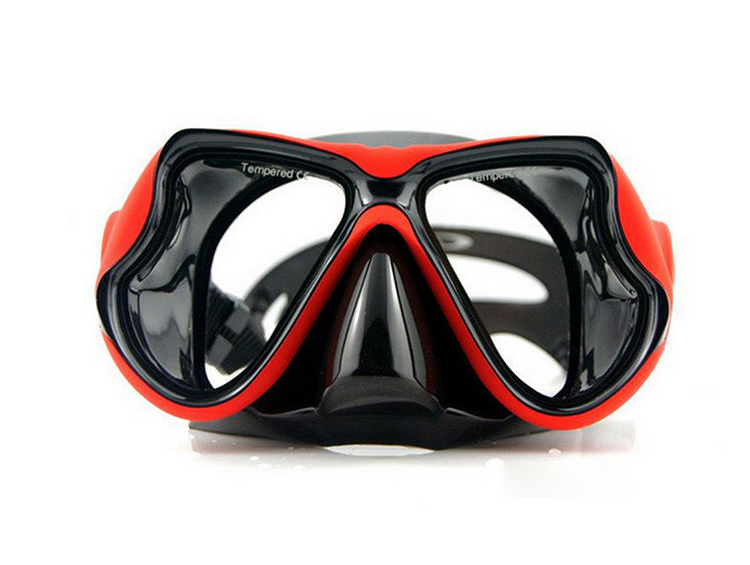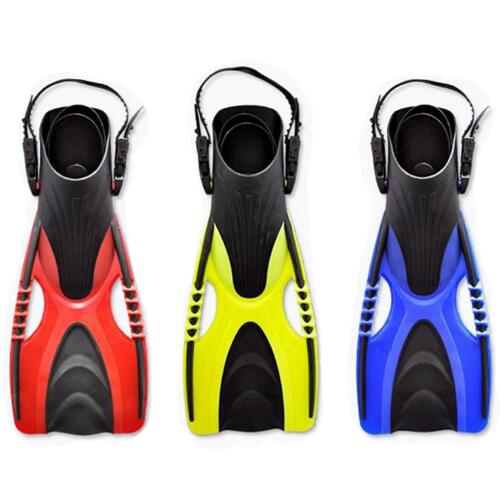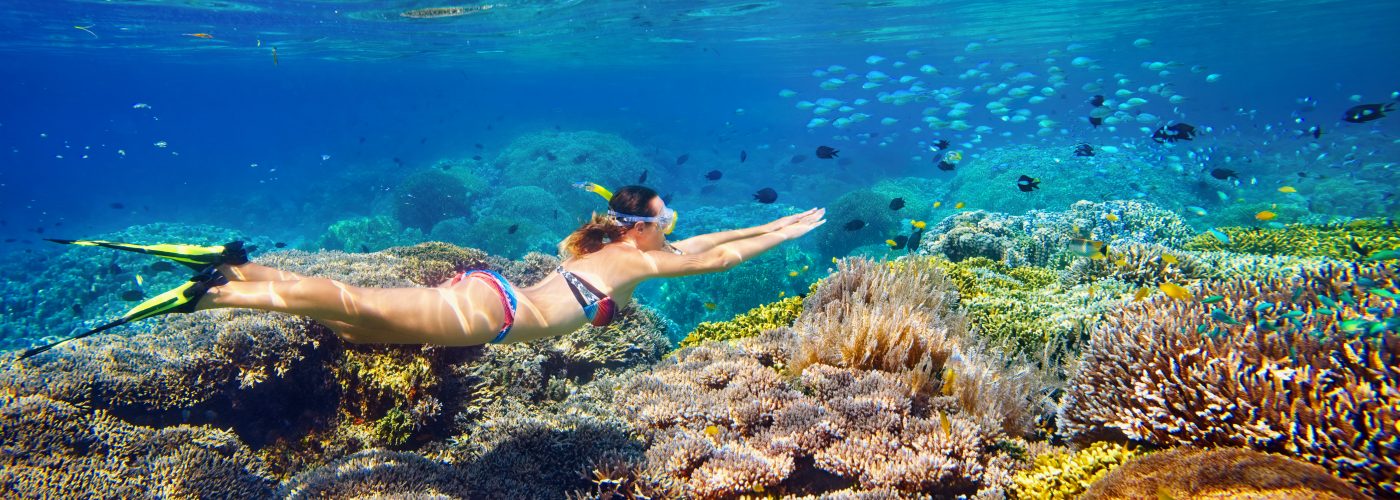How to use Snorkeling Sambo?2020-03-04
Beginners of snorkeling only need to know a few skills to use the snorkeling, because the snorkel(snorkel) solves the most difficult breathing problem in swimming, so it is much easier than learning to swim. The swimming style of the equipment does not mean that you can also swim after removing the equipment, so you must choose a qualified mask, snorkel, and flippers; this way you can ensure safety. Otherwise, any snorkel leakage, broken mirror belt, or broken fins may cause fatal danger during snorkeling.
Mask
It can be rubbed repeatedly with toothpaste before wearing to prevent fogging or a small amount of anti-fog liquid. Do not let hair or beard affect the sealing of the mask when wearing. When I first started to dive, I like to tighten the mask tightly. There should be no trace of water leakage. When you dive more, you will find that when the face is buried in the water, the water pressure will naturally hold the mask down without looking up. There will be no water. Once you get into the water, don't be nervous, raise your head immediately, still bury your head in the water, press the upper part of the mask with your hands to seal it, hold your mouth to breathe, the nose quickly and forcefully exhale, and the water will naturally be discharged from the mask. Pass the adhesive tape on the left side of the mask through the rubber ring or quick buckle on the snorkel. This is to keep the snorkel tube head up and to prevent the snorkel from loosening the snorkel when it snorkels.
The choice of mask, put the mask on the face (do not let the hair cover inside, which will affect the leak-proof performance), gently inhale through the nose, the mask can always be sucked on the face is suitable (during this process The nose cannot breathe). The vast majority of people do not need to choose a mask specifically for their face shape, but a few people do not. What kind of people should pay special attention to? People whose faces are significantly smaller than ordinary people, or who are significantly thinner and narrower (such as common in foreigners), these people need a narrow face (or youth); face People with very wide masks also need to choose a mirror with a wide mask, because a relatively wide mask will block the left and right eye corners, which affects the sight.
The mask is equipped with a silicone mask on the face, and the sunscreen on the face will have some impact on the tightness of the mask, but it is not obvious; you can strengthen the tightness of the mask by adjusting the tape. After wearing the mask, you can only breathe through your mouth.
The water accumulation problem of the mask: When you snorkel for a period of time, a little water will accumulate on the tip of the nose of the mask; this is a normal phenomenon. No matter how good a diving mask is, it cannot guarantee that the dive will be covered when the dive is under water pressure Part of the water completely infiltrated; but if it is not just a problem with a little water on the tip of the nose, it is really not worn.
[Note] The mask drainage method is a skill you need to master. When there is a small amount of water in the mask, you can raise your head by 45 degrees, and then hold the top of the mask with your hand and spray water with your nose to give water exhausted.

Snorkel
Bite the mouthpiece of the snorkel so that the teeth are just in the grooves of the silicone; do not rush to speed up when you are playing snorkeling, and slowly grasp the breathing rate. No matter how fast the snorkeling action is, the breathing should be kept even, so that the seawater will not be poured into the pipe from the drain valve. Full dry pipe and wet pipe (including semi-dry pipe): The full dry pipe can ensure that no water is poured into the pipe when diving, but the wet pipe cannot guarantee it. When floating up to the surface after diving with closed air, the wet pipe needs to blow air to blow the water in the filled pipe from the inlet pipe head and the drain valve, and then inhale and breathe.
Drainage during snorkeling: Even with a dry snorkel, there will be little water entering the water pipe during the closing of the float valve; although the amount of water will be small, it will sometimes make people feel uncomfortable. Needs drainage. Generally, when rising near the water surface or when the pipe head is exposed to the water surface, the air is blown out through the mouth, and the water in the pipe is blown out through the drain valve. A small amount of sea water is blown clean).
In the case of using a wet tube, even those who have good snorkeling experience and swimming skills, sometimes it is unavoidable that when inhaling on the floating surface, the water is not blown because of the seawater that is not blown; and from some just bought equipment to travel overseas According to the feedback from the authors, when novice snorkelers use non-dry pipes, they are almost certainly unable to blow in the seawater, which causes the backwater situation to cause some dangerous scenes. For example, some snorkeling in the Maldives is launched directly into the middle of the sea by boat. The water depth is a few meters to more than 10 meters, and the water can cause very serious consequences.
Snorkeling In order to facilitate diving, snorkelers are not equipped with life-saving aids, and dry snorkels can ensure that the snorkeling process does not inhale seawater to the greatest extent. In scuba diving, expensive BCD can be used after inflation. As a life jacket, the role of the snorkel is only to help divers save gas in the cylinder when the water is on the surface, so no dry tube is necessary in scuba diving. At present, there is no international standard for snorkeling equipment. Dry snorkels can be used as standard snorkels. It is recommended that snorkeling be equipped with dry snorkels to ensure their own safety to the greatest extent; for those who cannot swim themselves, they must use dry snorkels so that they can have a good time and have fun.
Flippers

Why use fins? In fact, if you look at the drainage area of your fins compared to the area of your soles, you will know how much more fins have an area of 4 times the area of your soles. People who are used to webbed feel barefoot in the water.
If you use it with diving socks, you will wear your feet less, and you will need to wear heels. Otherwise, you wo n’t be able to be connected in the water. The essentials of movement are the same as those of freestyle swimming when fast swimming, and thighs push the calf to push the water backwards during slow swimming, so that the body can move forward. Do not pull up and down with effort. Generally, this speed is fast enough. Can catch up. So snorkeling can also travel far away, provided that you have mastered the skills freely.
The flippers are divided into a full-foot type (or full-foot type, which can be worn barefoot, because it is easy to fall off and has a weaker propulsive force compared to the strap type, which is basically used for snorkeling) and strap type (or open-heeled) , Most styles need to wear diving shoes before they can be worn. The strap-type web has a relatively large area and strong propulsive force, which can be used for snorkeling and scuba diving.) However, tourist spots often use foot kits for scuba diving (because they don't dive in seas with complicated water conditions, and do not need powerful fins).
Before wearing the fins, remove the solid hard plastic block in the foot cover; when needed, wear diving socks or ordinary socks to reduce friction and comfort. The flippers do not have to slap the water as fast as the freestyle swim. The main thing is to swing the thighs up and down instead of the calves and ankles to make the fins slap the water (do not pat the fins with the force of the ankle, which is easy to cramp). The left and right speeds will make it easier for you to get started.
For those who can’t use the snorkeling snorkeling freely, such as those who are uncomfortable when using a mask and do not use fins, do not leave their water house too far, because once the water is soaked, they will be scratched by corals and taken by the tide. It's dangerous to be far away. At the beginning of snorkeling, you can choose to practice in the shallow waters of the white sand in the aquatic center. It is recommended to wear only diving socks and no fins, because you can only walk backwards after wearing fins. Practice snorkeling against obstacles. Wait until you have mastered the skills before going to the coral area, so as not to step on the corals or puncture your feet. After the dry duck mastered the use of the snorkeling sambo, put on a life jacket, put on the snorkeling sambo, and get a panoramic view of all the seabed.
- Company Info
- About Us
- Contact Us
- Wholesale
- News
- Customer Reviews
- User Center
- Forget Password
- My Orders
- Tracking Order
- My Account
- Register
- Payment & Shipping
- Customs & Taxes
- Shipping Methods
- Payment Methods
- How to place order?
- Company Policies
- Return Policy


